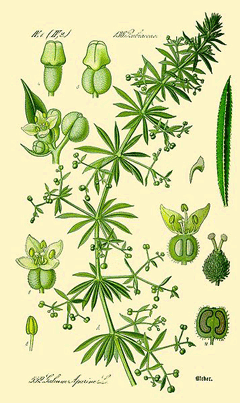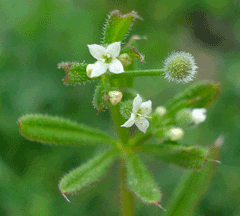 |
|
http://commons.wikimedia.org/wiki/File:Galium_aparine_b.jpg |
 |
| http://commons.wikimedia.org/wiki/User:Fornax |
Translate this page:
Summary
Physical Characteristics

 Galium aparine is a ANNUAL growing to 1.2 m (4ft) by 3 m (9ft 10in).
Galium aparine is a ANNUAL growing to 1.2 m (4ft) by 3 m (9ft 10in).
See above for USDA hardiness. It is hardy to UK zone 3 and is not frost tender. It is in flower from June to August, and the seeds ripen from August to September. The species is hermaphrodite (has both male and female organs) and is pollinated by Flies, beetles. The plant is self-fertile.
It is noted for attracting wildlife.
Suitable for: light (sandy), medium (loamy) and heavy (clay) soils. Suitable pH: mildly acid, neutral and basic (mildly alkaline) soils. It can grow in full shade (deep woodland) semi-shade (light woodland) or no shade. It prefers dry or moist soil.
UK Hardiness Map
US Hardiness Map
Synonyms
Aparine hispida, Aparine vulgaris, Asterophyllum aparine, Galium charoides
Plant Habitats
Woodland Garden Dappled Shade; Shady Edge; not Deep Shade; Hedgerow;
Edible Uses
Edible Parts: Leaves Shoots
Edible Uses: Coffee Tea
The tender young shoot tips - raw or cooked as a pot-herb[5, 7, 53, 55, 62, 172, 183]. A rather bitter flavour that some people find unpalatable[244], they are best used in the spring[178]. They make a useful addition to vegetable soups[7, 244]. It is said that using this plant as a vegetable has a slimming effect on the body[238]. The roasted seed is a coffee substitute[2, 53, 62]. One of the best substitutes, it merely needs to be dried and lightly roasted and has much the flavour of coffee[4, 115, 183]. A decoction of the whole dried plant gives a drink equal to tea[2, 4].
References More on Edible Uses
Medicinal Uses
Plants For A Future can not take any responsibility for any adverse effects from the use of plants. Always seek advice from a professional before using a plant medicinally.
Alterative Antiphlogistic Aperient Astringent Cancer Depurative Diaphoretic Diuretic
Eczema Febrifuge Homeopathy Skin Tonic Vulnerary
Goosegrass has a long history of domestic medicinal use and is also used widely by modern herbalists. A valuable diuretic, it is often taken to treat skin problems such as seborrhoea, eczema and psoriasis, and as a general detoxifying agent in serious illnesses such as cancer[254]. The whole plant, excluding the root, is alterative, antiphlogistic, aperient, astringent, depurative, diaphoretic, diuretic, febrifuge, tonic and vulnerary[4, 7, 9, 21, 165, 218, 222]. It is harvested in May and June as it comes into flower and can be used fresh or dried for later use[4, 238]. It is used both internally and externally in the treatment of a wide range of ailments, including as a poultice for wounds, ulcers and many other skin problems[4, 7, 244], and as a decoction for insomnia and cases where a strong diuretic is beneficial[4]. It has been shown of benefit in the treatment of glandular fever, ME, tonsillitis, hepatitis, cystitis etc[238]. The plant is often used as part of a spring tonic drink with other herbs[4]. A tea made from the plant has traditionally been used internally and externally in the treatment of cancer[4, 218, 222]. One report says that it is better to use a juice of the plant rather than a tea[254]. The effectiveness of this treatment has never been proved or disproved[7]. Both Asperuloside (a terpenoid) and Coumarin (a benzopyrone) occur in some species of Galium. Asperuloside can be converted into prostaglandins (hormone-like compounds that stimulate the uterus and affect blood vessels), making the genus of great interest to the pharmaceutical industry[238]. A homeopathic remedy has been made from the plant[7].
References More on Medicinal Uses
The Bookshop: Edible Plant Books
Our Latest books on Perennial Plants For Food Forests and Permaculture Gardens in paperback or digital formats.

Edible Tropical Plants
Food Forest Plants for Hotter Conditions: 250+ Plants For Tropical Food Forests & Permaculture Gardens.
More

Edible Temperate Plants
Plants for Your Food Forest: 500 Plants for Temperate Food Forests & Permaculture Gardens.
More

More Books
PFAF have eight books available in paperback and digital formats. Browse the shop for more information.
Shop Now
Other Uses
Cleanser Dye Filter Tinder
A red dye is obtained from a decoction of the root[4, 7, 168]. When ingested it can dye the bones red[4]. The dried plant is used as a tinder[99]. The plant can be rubbed on the hands to remove pitch (tar)[99]. The stems are placed in a layer 8cm or more thick and then used as a sieve for filtering liquids[4, 115, 172].
Special Uses
Attracts Wildlife Dynamic accumulator
References More on Other Uses
Cultivation details
Prefers a loose moist leafy soil in some shade[200]. Plants tolerate dry soils, but they quickly become scorched when growing in full sun[200]. They do not thrive in a hot climate[200]. Another report says that plants succeed in most soils in full sun or heavy shade. A scrambling plant, the stems and leaves are covered with little hooked bristles by which it can adhere to other plants and climb into them[4]. A good species to grow in the wild garden, it provides food for the larvae of many butterfly species[30].
References Carbon Farming Information and Carbon Sequestration Information
Temperature Converter
Type a value in the Celsius field to convert the value to Fahrenheit:
Fahrenheit:
The PFAF Bookshop
Plants For A Future have a number of books available in paperback and digital form. Book titles include Edible Plants, Edible Perennials, Edible Trees,Edible Shrubs, Woodland Gardening, and Temperate Food Forest Plants. Our new book is Food Forest Plants For Hotter Conditions (Tropical and Sub-Tropical).
Shop Now
Plant Propagation
Seed - best sown in situ as soon as the seed is ripe in late summer[200]. The seed can also be sown in spring though it may be very slow to germinate[200]. Once established, this plant does not really need any help to reproduce itself.
Other Names
If available other names are mentioned here
Native Range
NORTHERN AMERICA: United States (Alabama)
Weed Potential
Right plant wrong place. We are currently updating this section.
Please note that a plant may be invasive in one area but may not in your area so it's worth checking.
Conservation Status
IUCN Red List of Threatened Plants Status :

Growth: S = slow M = medium F = fast. Soil: L = light (sandy) M = medium H = heavy (clay). pH: A = acid N = neutral B = basic (alkaline). Shade: F = full shade S = semi-shade N = no shade. Moisture: D = dry M = Moist We = wet Wa = water.
Now available:
Food Forest Plants for Mediterranean Conditions
350+ Perennial Plants For Mediterranean and Drier Food Forests and Permaculture Gardens.
[Paperback and eBook]
This is the third in Plants For A Future's series of plant guides for food forests tailored to
specific climate zones. Following volumes on temperate and tropical ecosystems, this book focuses
on species suited to Mediterranean conditions—regions with hot, dry summers and cool, wet winters,
often facing the added challenge of climate change.
Read More
Expert comment
Author
L.
Botanical References
17
Links / References
For a list of references used on this page please go here
Readers comment
© 2010, Plants For A Future. Plants For A Future is a charitable company limited by guarantee, registered in England and Wales. Charity No. 1057719, Company No. 3204567.